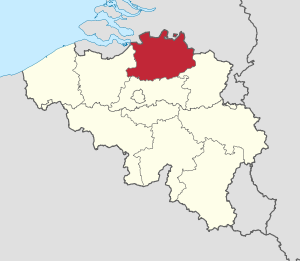 | WARNING: Due to the outbreak of the contagious disease COVID-19 (see coronavirus pandemic), caused by the virus SARS-CoV-2, also known as coronavirus, there are travel restrictions worldwide. It is therefore of great importance to follow the advice of the official bodies of Belgium and Netherlands to be consulted frequently. These travel restrictions may include travel restrictions, closure of hotels and restaurants, quarantine measures, being allowed to be on the street for no reason and more, and can be implemented with immediate effect. Of course, in your own interest and that of others, you must immediately and strictly follow government instructions. |
The The province of Antwerp[1] is one of five Flemish provinces of Belgium. It is the only province of Flanders that is named after its own provincial capital.
It borders the provinces East Flanders, Flemish Brabant and Limburg. Belgium owes a lot to the port of Antwerp.
Regions

Towns
- Antwerp
- Arendonk
- To compress
- order
- Tree
- Brasschaat
- Yellow
- gooreind
- mortar
- hemiksem
- Herentals
- malle
- Mechelen
- Mol
- Niel
- niles
- Chapels
- Calmthout
- Winch
- Olen
- putte
- Rumst
- Schelle
- shield
- shots
- Turnhout
- Zwijndrecht
Info
Antwerp originated from the Duchy of Brabant, one of the leading regions of the Netherlands. That duchy included the present-day provinces of North Brabant, Antwerp, Flemish Brabant, Walloon Brabant and the capital region of Brussels. During the Eighty Years' War, Brabant was divided between the Spanish Netherlands and the Republic of the Seven United Netherlands. The northern part became part of the Republic, the southern part became part of the Southern Netherlands. After the French invasion in 1795, Brabant was divided into the departments of Twee Neten and Dijle. After the Allied liberation in 1815, these departments were renamed Antwerp and South Brabant.
After the formation of the United Kingdom of the Netherlands, Antwerp, especially the port of Antwerp, experienced a period of unprecedented prosperity. This was due to the end of the Napoleonic Wars and the reopening of the Scheldt.
After the Belgian Revolution, Belgium followed a more continental policy, from which Wallonia and Limburg in particular benefit. Antwerp is experiencing a depression, because trade has become more difficult, partly due to the politics. Due to its location close to the Netherlands, in the province of Antwerp Dutch remains the most protected against the policy of Frenchification decided upon by the government.
Gradually, the economy recovered and Antwerp started to keep up with its long-standing rival Rotterdam. After the Second World War, Antwerp becomes part of the 'Flemish industrial diamond'.
Language
The official language is Dutch, but most Antwerp residents will also be able to speak to you in English.
In general, the dialects from the province are classified under Brabants. Furthermore, the dialects can be subdivided as Kempen-Brabants and then Zuiderkempens and more specifically the subgroup of the "heirbaan dialects" (the dialects that arose along the heirbaan towards Dordrecht). The real Antwerp and Mechels are typical urban dialects, which are clearly distinguishable from the dialects from the surrounding areas, such as West Flemish.
It is the only province in Flanders where there are no municipalities with facilities.
Arrive
The main highways that cross the province are the E19, A12, E313, E17 and E34. In addition, the cities of Antwerp (R1 and R2), Lier (R16), Mechelen (R12), Turnhout (R13) and Herentals (R15) have a ring road.
Several important railway lines run through Antwerp, connecting the province with the surrounding provinces and abroad: Antwerp-Brussels, Antwerp-Ghent and Antwerp-Rotterdam/Amsterdam are the most important. The most important stations are Antwerp Central, Berchem, Mechelen and Lier.
Various bus lines of the transport company De Lijn connect the municipalities of the province with each other and with the municipalities in the surrounding provinces. The most important "bus stations" are in Antwerp, Mechelen, Oostmalle, Turnhout, Hoogstraten, Lier, Willebroek, Mol and Heist-op-den-Berg.
Travel around
- Public transport is provided by De Lijn [2] by tram or bus.
- There is a bicycle network system like in other cities, but can only be used via pre-registration.
In the boroughs around Antwerp you will find great fortresses named by number.
These forts have usually been converted into a nature park or recreation area. A few of the forts are closed and are now nature reserves (eg Fort 7).
To do
- Bobbejaanland, light map (bus 305, from Herentals, Aarschot or Leuven station).
Food
Going out
Safety
It is very safe in the province of Antwerp, the city of Antwerp is also a safe city. The same warning as for other big cities is this: the presence of many tourists also attracts some suspicious figures, don't be careless.
all around
| This is a usable article. It contains information on how to get there, as well as the main attractions, nightlife and hotels. An adventurous person could use this article, but dive in and expand it! |
| Regions of Antwerp (province) |
|---|
| Provinces of Belgium |
|---|
Antwerp · Hainaut · shutter · Limburg · Luxembourg · Namur · East Flanders · Flemish Brabant · Walloon Brabant · West Flanders |

